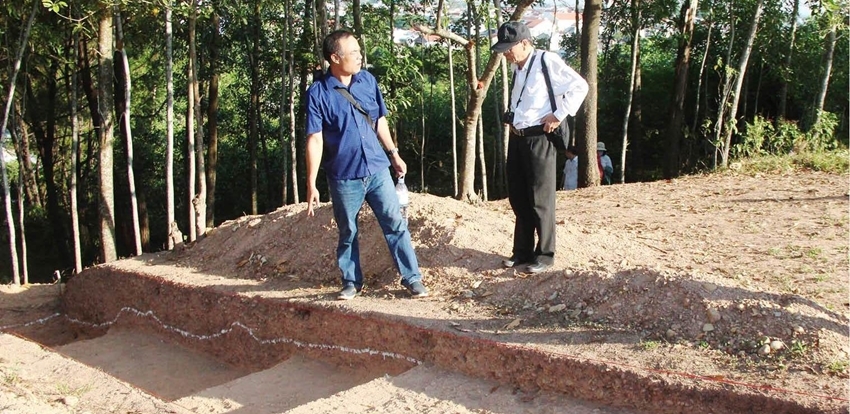    |
 |
| The National Relic of Mount Ban - where experts conducted excavations |
Phase 2 of the excavation of the National Relic of Mount Ban ended in mid-June. Previously, phase 1 was completed at the end of July 2022, with a lot of interesting and new information being discovered. This excavation was carried out by experts from the National Museum of History in collaboration with the Department of Culture and Sports.
Excavating twice to find the answer
The excavation team has published some important information along with the comments and assessments of some historians. In phase 1, experts dug 9 holes in the West, South, East and North with an area of nearly 150m2. In these pits, there were vestiges of stone embankment foundation, brick embankment, leveled ground surfaces and slope lines, clearly reflecting the scale and nature of the relic. Bricks and stones were also revealed in this excavation, and the assessment of the cover bricks obtained have determined that the nature and age of such artifacts dated back to the 18th century.
It was, therefore, initially determined that Nam Giao Esplanade under Tay Son dynasty was built at Mount Ban with a square base, surrounded by stone and brick embankments. The top included 3 layers of soil, created in a truncated cone shape by cutting the mountainside on the basis of egg-shaped contour lines, forming three base rings of unequal height and width, with the circumference of the rings of the background gradually decreasing according to the height of the mountain.
Mr. Nguyen Ngoc Chat, Deputy Head of the Research and Collection Department (National Museum of History), who directly participated in the excavation, said that from the vestiges discovered in phase 1, the team proposed to conduct phase 2 of the excavation. In phase 2, experts expanded the digging holes, developed successively the surfaces with a total area of more than 200m2 to clarify the scale and structure. As a result, it was discovered that in addition to the natural rocky cliffs being the edges of the esplanade, many positions were built and supplemented with bricks and stones to form an octagonal ground, with each side being 32-33m long.
“The vestiges of stone embankment and bricks, especially those found in dug holes, were revealed, and the assessment of such artifacts have determined that the nature and age of them dated back to the 18th century. The size and color of the bricks here are completely similar to those of the foundation bricks found in the temples and palaces of the Nguyen lords and the architectural works built in the early Nguyen dynasty. That contributes to proving the authenticity of the Esplanade built at Mount Ban under Tay Son dynasty,” said Mr. Chat.
The special significance at the national level
According to this expert, the excavated relics, besides displaying and introducing the materials involved in the construction of the esplanade, also have an important meaning in comparing documents, effectively serving the practices of doing research, preserving, embellishing and promoting the value of relics of Tay Son dynasty in the land of Phu Xuan - Hue.
Upon going into detail about this national relic recognized in 1988, Mr. Chat said that Mount Ban needed to be further researched, preserved and honored. In particular, it is necessary to prepare documents soon to proceed to the construction of a special national relic profile.
According to the information at both stages of archaeological excavations, Dr. Phan Tien Dung, Chairman of the Provincial Historical Science Association, said that in parallel with the process of building a profile to become a special national relic, it was necessary to embellish the space of the national relic of Mount Ban. Besides, there needs to be a place to display the values of Tay Son dynasty.
Talking more about the National Relic of Mount Ban, Mr. Phan Thanh Hai – Director of the Department of Culture and Sports – acknowledged that it could be said that the National Relic of Mount Ban has special significance not only within Hue ancient capital, but at the national level as well. Therefore, archaeological excavations have added a lot of documents, thereby discovering a lot of interesting information.
Based on such archaeological results, Mr. Hai said he would propose to the provincial leaders so that the department could develop a dossier and propose to recognize the National Relic of Mount Ban and its related parts as a special national relic. Along with that, it is necessary to carry out detailed planning of this area, building a number of appropriate cultural institutions, such as restoring the relics of Mount Ban with correct information through excavations, building temples to commemorate Emperor Quang Trung and famous generals and civil servants under this dynasty, planning to turn it into a major hub of the west of Hue city – a very densely populated place; expanding and embellishing Mount Ban and the nearby Mount Ngu Binh.
Mount Ban, 43m high, located in the south of Mount Ngu Binh, is also called Hon Thien (Hon Thieng), Mount Ba Tang, or Ba Vanh. At the end of 1788, King Nguyen Hue held a ceremony to ascend the throne here, proclaiming himself Quang Trung Emperor, and then mobilized his army to the North to defeat the Manchu army led by Ton Si Nghi.
Over the past 100 years, the National Relic of Mount Ban has been ranked and put into the area of protection. Most recently, in 2008, there was a project to embellish National Relic of Mount Ban along with the construction of a square and a monument of Emperor Quang Trung with a total area of more than 25,000 square meters right next to it.